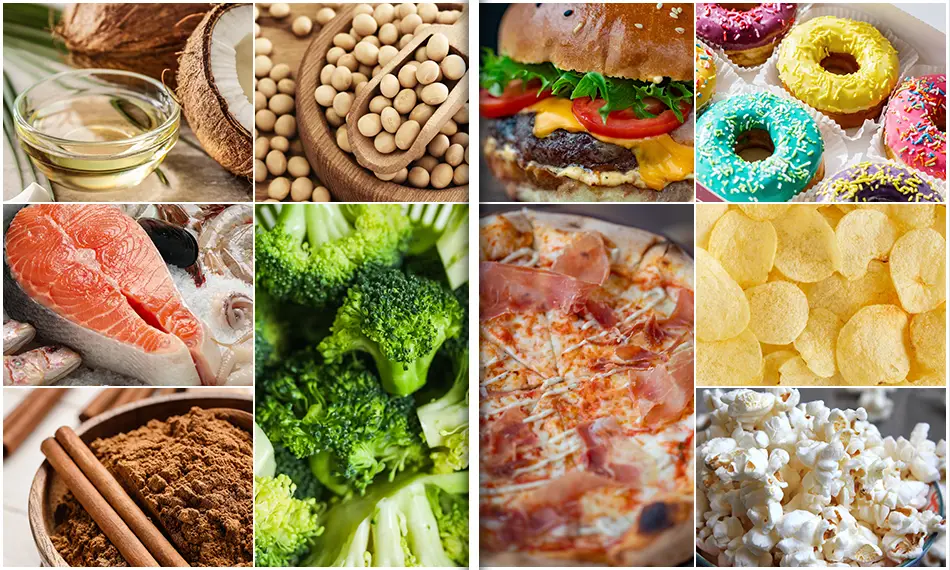3 Ways to Balance Junk Food and Healthy Eating
There is no “right” or “wrong” food, and sometimes it is okay to indulge. The question is, how do we do it in the healthiest way possible? In this article, our nutritionists share 3 strategies for maintaining a balanced diet without sacrificing the occasional treat.

We know that good nutrition leads to good health. A balanced diet reduces the risk of diabetes, stroke, cancer, and heart disease. It also boosts productivity and the immune system.
Fast food, on the other hand, leads to obesity and related health problems because it is packed with calories, sugar, and trans fats.
Nutrition trends urge us to constantly watch what we eat. We fear that even a single nugget among the quinoa and kale will sabotage our efforts to eat healthily. The result is neurosis and guilt.
The wellness industry divides food into healthy and unhealthy. However, pizza can provide comfort during hard times, and fresh spinach can lead to kidney stones.
Eating a healthy, balanced diet doesn’t mean depriving yourself of your favorite foods. But eating everything all the time is not a good idea either.
So how can you balance your diet without feeling restricted or overwhelmed? Read on to find out how to live healthy and happy with 3 effective strategies from our nutritionists.
Beyond Black and White: Navigating the Nuances of Nutrition
Into which 2 categories would you place the products in the following table?
| Green vegetables, legumes, whole grains, fish, eggs, coconut oil, cinnamon, fresh fruits | Pizza, burgers, chips, popcorn, fries, donuts, hot dogs, milkshakes, pancakes, bacon |
These categories are clearly different. The first group of foods is minimally processed and high in nutrients. In the second group, you’ll find highly processed, nutrient-poor foods. Like white and black, they’re opposites in terms of nutritional value.

However, an excess of broccoli in the diet increases thyroid disease risk.1 For all its health benefits, coconut oil is high in saturated fats, while freshly squeezed juices are high in sugar.2, 3 Even cinnamon can harm the liver.4
“Never eat that”
In the context of healthy nutrition, there is no official medical recommendation in which some foods will be labeled as dangerous.
For example, let’s consider trans fats. Based on studies, they increase the risk of heart attacks, type 2 diabetes, and strokes.5
However, the WHO doesn’t ban trans fats. According to official recommendations, trans fats should only be limited to 1% (approx. 2 grams) of the total calories consumed.6
So eating junk food a few times a month won’t hurt you. That’s much better than constantly denying yourself pleasure and getting depressed.
Here’s a lesson in balance
There is a story about a teenager who became blind after eating only 4 foods his entire life: french fries, white bread, chips, and processed pork.7 This case is extreme – usually, people eat different foods, but there is a lesson.
Burgers, tacos, and croissants should not crowd out vegetables, beans, nuts, fish, and other nutrient-dense whole foods from your diet. Food should be varied, and yes, sometimes it can be nutrient-poor as well.
Fast food makes us happier
The concept of general health is more than just weight, cholesterol, or blood sugar.According to WHO, health is a state of complete physical, mental, and social well-being and not merely the absence of disease or infirmity.8
Junk food improves our mental health. Studies found that overweight children who ate fast food and drank soft drinks were less likely to be unhappy.9 Moreover, junk food releases the “happy hormone,” dopamine, which makes us feel positive.10
So, defining junk food as “bad” and high-in-nutrient food as “good” is not accurate, and we need different foods to maintain mental and physical health.
But how to balance them? Should it be some inner feeling or a strict timetable you need to follow?
Together with nutritionist Edibel Quintero, we answered those questions and described effective ways to balance your nutrition.
#1 Mind Your Eating
During one study, people who followed a certain diet were told about the dangers of junk foods. After that, their cravings for this food increased.11


Why not just avoid eating junk? It might be easier and more beneficial for some individuals in specific situations, such as those with severe food allergies. Yet, for most people, staying abstinent should not be the case. Once you develop new habits, you can move from avoiding certain foods to eating them in moderation.
The internet is full of tips on how to eat mindfully, and many of them include dozens of questions to ask yourself before eating, keeping a food diary, or adjusting the atmosphere in which you consume food. For those who don’t have that much time, here’s a simple piece of advice that requires little time and effort.
Ask yourself these 3 questions before you eat:
- What are the benefits of eating this food?
- What nutritional value does this food provide?
- What role does it play in my overall diet?
Considering the benefits, nutritional content, and how a certain food fits into your diet will help you make balanced choices. The goal is to find a way to get from point A to point B – from loss of control to a sense of pleasure from moderate consumption.
#2 Define Your Nutritional Context


I came up with nutritional context a couple of years ago. It covers 3 scopes: health aspects, eating behaviors, and dietary goals. The aim is to give you a complete picture of how you eat, which is most often an automatic process your brain manages.
Health aspects
Due to many physiological and psychological factors, the same food affects different people in different ways. Instead of completely eliminating the “bad” products, look at your health aspects, such as:
- Fitness level
- The current health state
- Diseases
- Allergic reactions and intolerances
- Psychological condition
- Food preferences
Considering these factors can help you determine what’s right for you in terms of nutrient-rich and nutrient-poor foods.
For example, people who are physically active and generally healthy can enjoy fast food in moderation. People with high blood pressure or diabetes should focus on foods low in sodium and sugar.12
Fast food can be a great stress reliever if you’re busy or don’t have time to cook. Even if you like a particular type or flavor of junk food, you can find healthier versions within those categories that fit your dietary goals.
Eating behaviors
Think about the reasons why you eat specific foods. It may be:
- Regular hunger
- Emotional stress
- Fatigue
- Intentional pleasure


Thinking about why we eat helps us form healthier habits and have a better post-eating experience. For example, if you feel tired and you recognize it, you can choose alternative ways of resting. Instead of eating a pizza, do a quick meditation or take a nap.
Dietary goals
Depending on what you eat, you can make progress faster or harder. How do you define your nutrition goals? Some examples are:
- Weight loss/gain
- Post-training recovery
- Overall health improvement
- Sports performance
- Mental well-being
Once you’ve identified your goal, you can build your interaction: eat more of the foods you need and less of the foods you don’t.
For example, it may be beneficial to eat high-calorie foods if you are trying to gain weight. Eating carbohydrates after exercise will help with recovery and improve performance during exercise.13
#3 Flex Your Eating Habits
Let’s say you’ve defined your nutritional context and eating goals. You’re clear on your current diet, and you’re determined to stick to it.
Suddenly something happens.
A coworker might bring in a homemade lemon cake and leave it on your desk at work. Or, after a stressful day, you indulge in a Ben & Jerry’s chocolate chip ice cream and immediately regret it.
The problem with a hard-and-fast approach to nutrition is that it’s the enemy of consistency. In order to maintain consistency, you need flexibility.
Flexibility allows you to adapt to unexpected situations, like those tempting lemon cakes or a stressful day that leaves you craving comfort food.
For example, instead of avoiding sugar just because some health website has banned it, you might think:
- Am I hungry?
- Am I nervous now?
- Should you eat this food at all?
- What else did I eat today?
- How can I enjoy this food without overdoing it?
Imagine having an inner conversation with a homemade lemon cake. Say something like, “I really love you, but I’ll save you for dinner when I’m not so hungry and can enjoy you slowly.”
Or imagine holding an empty bucket of ice cream and thinking, “I probably ate more ice cream than my body needed. How can I avoid feeling this way in the future? Are there other ways to feel better that don’t involve raiding the fridge?”


The idea is to free yourself from the good/bad food mindset to see more possibilities. Keeping your mind flexible will allow you to enjoy every meal more, achieve your goals faster and make your own dietary decisions to support your overall health.
The Bottom Line
A healthy diet, both physically and mentally, is about balance: getting all the nutrients you need while enjoying your food. Being mindful and critical of what you eat, understanding your nutritional context, and staying flexible will make your life healthy and happy.
Remember that well-being extends far beyond food. Connecting with loved ones, traveling, exercising, enjoying the arts, and being outdoors can be just as enjoyable as a double cheeseburger with fries.
Sources
- Effect of broccoli sprouts on thyroid function, haematological, biochemical, and immunological parameters in rats with thyroid imbalance:
https://pubmed.ncbi.nlm.nih.gov/29080462/ - Coconut oil and palm oil’s role in nutrition, health and national development: A review
https://www.ncbi.nlm.nih.gov/pmc/articles/PMC5044790/ - Are Fruit Juices Healthier Than Sugar-Sweetened Beverages? A Review:
https://www.ncbi.nlm.nih.gov/pmc/articles/PMC6566863/ - The effect of cinnamon supplementation on liver enzymes in adults: A systematic review and meta-analysis of randomized controlled trials
https://pubmed.ncbi.nlm.nih.gov/33639251/ - Intake of saturated and trans unsaturated fatty acids and risk of all cause mortality, cardiovascular disease, and type 2 diabetes: systematic review and meta-analysis of observational studies:
https://pubmed.ncbi.nlm.nih.gov/26268692/ - Nutrition: Trans fat
https://www.who.int/news-room/questions-and-answers/item/nutrition-trans-fat - Blindness Caused by a Junk Food Diet:
https://www.acpjournals.org/doi/10.7326/L19-0361 - Constitution of the World Health Organization — WHO:
https://www.who.int/about/governance/constitution - Hung-Hao Chang and Rodolfo M. Nayga. Childhood Obesity and Unhappiness: The Influence of Soft Drinks and Fast Food Consumption. Journal of Happiness Studies, 2009; DOI: 10.1007/s10902-009-9139-4
- The Impacts of Junk Food on Health — Frontiers for Young Minds
https://kids.frontiersin.org/articles/10.3389/frym.2022.694523 - Pham N, Mandel N, Morales AC. Journal of the Association for Consumer Research. 2016 Jan 1;1(1):175–90:
https://www.journals.uchicago.edu/doi/abs/10.1086/684394 - The wrong white crystals: not salt but sugar as aetiological in hypertension and cardiometabolic disease
https://www.ncbi.nlm.nih.gov/pmc/articles/PMC4336865/ - Carbohydrate intake and recovery from exercise — ScienceDirect:
https://www.sciencedirect.com/science/article/abs/pii/S076515970400053X

















































 Select your language:
Select your language: 







